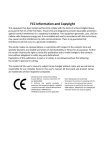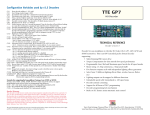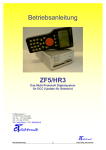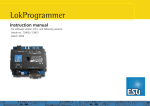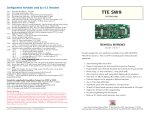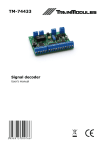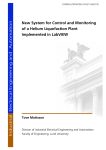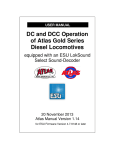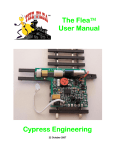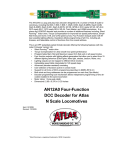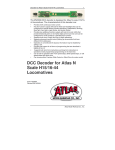Download User manual Combi-decoder SL51-2 for N and H0
Transcript
4 Combined Decoder SL51-2 108 109 110 111 112 113 116 121 122 123 124 125 126 127 128 129 130 131 132 133 134 135 136 137 138 139 140 141 142 143 144 Bitmask for endless manual sound: ONLY operational when CV49 Bit 5 is set. For use with LGB pulse chains Bit 0 for sound 1, Bit 1 for sound 2, Bit 3 for sound 3 aso…… Bit 6 for sound 7 Selection of CV Sets: Bit 0 = 0 ? CV-Set 1, Bit 0 = 1 ? CV-Set 2 for various use. Hard Reset will only effect the selected CV-set, CV109 will be unchanged by Hard Reset Load dependent sound variation: CV110 = 0 ? no load dependent sound variation CV110 = 1 ? high dependency, CV110 = 15 low dependency to loadchanges Intensiy of acknowledgment pulse (ACK): improves the programming capability, 128 = ca. 50% of max. acknowledgment puls (Motor dependent) 150 = normal RAND_1: Selection of aux. sound in idling (see CV131) CV112 = 0 ? auxillary sound off Bit 0 - 7 ? Selection of auxillary sound RAND_2: Selection of aux. sound in running condition (see CV131) CV113 = 0 ? auxillary sound off Bit 0 - 7 ? Selection of auxillary sound Shunting function (yard mode): F3 default (CV37) remappable see CV35-42 Bit 0 = 1 ? CV3 and CV4 is disabled Bit 1 = 1 ? max. speed will be half going forward and reverse Bit 2 = 1 ? reverse only 65% max. speed (independent of shunting mode) Register 0: Sound level main sound (running sound) 1 = low, 2 = medium, 3 = high, F1, CV121=0 ? off Register 1: Bit 0 - 1 aux.function 1 : Bit 2- 7 for number of repetitions, F2, CV122=0 ? off Register 2: Bit 0 - 1 aux.function 2 : Bit 2- 7 for number of repetitions, F3, CV123=0 ?off Register 3: Bit 0 - 1 aux.function 3 : Bit 2- 7 for number of repetitions, F4, CV124=0 ? off Register 4: Bit 0 - 1 aux.function 4 : Bit 2- 7 for number of repetitions, F5, CV125=0 ? off Register 5: Bit 0 - 1 aux.function 5 : Bit 2- 7 for number of repetitions, F6, CV126=0 ? off Register 6: Bit 0 - 1 aux.function 6 : Bit 2- 7 for number of repetitions, F7, CV127=0 ? off Register 7: Bit 0 - 1 aux.function 7 : Bit 2- 7 for number of repetitions, F8, CV128=0 ? off Strong time: Time, when the sound after accelaration si being strongly reduced (unit: 0,5 seconds, valid for sounds in position 00-03 in the filelist) Weak time: Time, when the sound after breaking is being slightly reduced (unit: 0,5 seconds, valid for sounds in position 08-11 in the filelist) Rand time: Minimum time between two aux.sounds (unit: 0,5 seconds! ) Stroke Base H: Time between two steam strokes at speed step full speed. Stroke Base L: Time between two steam strokes for logical speed step 1 in seconds. 153 = 9,6 sec. Constant K = 1476 / time 1. Exampel: 20 seconds wanted K = 1476 / 20 = 73,8 rounded 74; ? CV133 = 74, CV134 = 0. 2. Exampel: 3 seconds: K = 1476 / 3 = 492. for K>256 splitting into high and lowbyte is necessary CV134 = K / 256 (not rounded, decimals is simply cut off) 492 / 256 = 1,927875 ? CV134 = 1 CV133 = K - (CV134 * 256) = 492 - (256 * 1) = 236 Time between steam strokes: the time between 2 steam strokes at logical speed step 1 in seconds (see CV133) Highbyte is set in CV 134. Frequency_min: Sound pitch in lower range () 64 = default pitch Frequency_max: Sound pitch in higher range () 64 = default pitch Special CV: CV137 valid for F0 – F12, between. CV33 – CV46 remappable. Bit0 – Function selection 0 = 8 Functions, 1 = 14 Functions (MAN Bit) Bit1 = Zimo – Train numberimpuls: 0 = off, 1 = on Bit2 = 1: strong/normal/weak switched with F1, only if CV110 is active, dimmable over CV54 Bit3 = 1: strong/normal/weak switched with F2, only if CV110 is active, dimmable over CV54 Bit4 = 1: Zimo speed control (HLU, MX9) 0 = off, 1 = on Break time (HLU): Break delay for HLU section (For Zimo systems only) Shortcircuit-threshold 1: direct cut-off at overload of functional outputs Shortcircuit -threshold 2: fast cut-off at overload of functional outputs Shortcircuit -threshold 3: slow cut-off at overload of functional outputs Shortcircuit-threshold 1: direct cut-off at overload of motor output Shortcircuit -threshold 2: fast cut-off at overload of motor output Shortcircuit -threshold 3: slow cut-off at overload of motor output 0 0 0 - 255 0-1 4 1 - 15 255 0 - 255 255 0 - 255 255 0 - 255 0 0 - 255 User manual Combi-decoder SL51-2 3 1-3 96 96 96 96 96 96 96 1 1 1 1 1 1 1 - 255 - 255 - 255 - 255 - 255 - 255 - 255 4 0 - 255 4 20 100 0 - 255 0 - 255 0 - 255 153 0 - 255 0 0 - 255 64 128 0 - 255 0 - 255 0 0 - 255 3 10 8 6 60 50 40 0 0 0 0 0 0 0 - 255 - 255 - 255 - 255 - 255 - 255 - 255 Table 2 CV Table for N and H0-scale Size 27/15/,.8mm (L/B/H) Picture 1 the Decoder Safety disclaimer Not suitable for children under three years of age because of the danger of their swallowing the small constituent pieces. Improper use can result injury from functionally necessary points an edges. For use only in dry areas. We reserve the right to make changes in line with technical progress, product maintenance or changes in production methods. We accept no responsibility for error that may occur of similar reason. We accept no responsibility for direct or indirect damage resulting from improper use, non-observance of instructions, use of transformers or other electrical equipment that is not authorised for use with model railways or transformers and other electrical equipment that has been altered, adapted or are faulty. Nor can we accept we accept responsibility for damage that results from unsupervised adjustments to equipment or from acts of violence or from overheating or from effects of moisture etc. Furthermore in all such cases the guarantee becomes invalid The SL51-2 is delivered mounted in tubing. Fi t the decoder using double-sided adhesive tape, there should be no contact between metal parts such as locomotive chassis or locomotive housing and the electronic of the decoder. Insulate all metalparts with insulation tape so that shortcircuit can be avoided. Never cover the decoder with insulation tape, that will reduce the aircirculation around the decoder wich could harm the decoder. Never touch the decoder when it is under power, this may damage both the software and hardware of the decoder. Grillparzergasse 5 A-2700 Wiener Neustadt Tel. Fax : +43 2622 82086 Tel.: +43 664 4719963 http://www.tran.at e-mail: [email protected] CT-Elektronik, www.tran.at 2 1. Combined Decoder SL51-2 Technical data and installation Combined decoder SL51-2 2. Track voltage DCC............................................................................................................ 10-24V Maxim um continuos current to motor....................................................................................... 1.5A Maxim um peak current to motor 5sec ......................................................................................... 2A Maximum continuos current aux. f unctions .......................................................................each 0.5A Maxim um total current all aux. f unctions.................................................................................. 1.5A High frequency motor control............................................................................................... 16kHz Low frequency motor control........................................................................................ 30 – 150 Hz Dimming frequency ..............................................................................................................80Hz Maxim um continuos output sound ................................................................................ 1W/32 Ohm Maxim um sound memory capacity at 11kHz, 8 Bit (Mono) ......................................... 44-160 Seconds Operating temperature................................................................................................. -10 to 90°C Dimensions ............................................................................................ (L x B x H) 27/15/3,8 mm Configuration table (CV’s) CV 1 2 3 4 5 6 7 8 9 13 17+18 19 Table 1 Technical data 1.1. Connection of the SL51-2 29 SL51-2 view from above Reed 2 Reed 1 SL51-2 Ansicht von oben 30 Motor rechts (orange) Schiene rechts (rot) Motor links (grau) Schiene links (schwarz) Speak + (braun) Plus + (blau) Speak - (braun) 33 - 42 43 - 46 105 106 User-CV : free for remembering purchase date or similar user information 107 Break threshold: Trigging of break sequence, CV107 = 50 ? Break sequence will be triggered between speedstep 25-24 CV107 = 0 ? Break sequence will be triggered between speedstep 1-0 50 51 52 Hard Reset: CV1 = 0 resets all CV´s depending on setting of CV109 to factory setting. Connection: The connected loudspeaker must have an impedance of min. 32 Ohm, if the intended loudspeaker has a lower impedance a resistor must connected in series with the loudspeaker giving a combined resistance of minimum 32? . 53 For use of a Reed contact for synchronized steam stroke the Reed contact 1 should be connected to the positive pole (blue). 54 The idle current consumption of the decoder is ca. 50mA this is due to the LF-amplifier. A heat release at idle load is therefore harmless. In operation under load the cooling element may reach a temperature up to 90°C. At track voltages over 24V the decoder must be mounted on a metal surface (for example locomotive chassis) so that heat can be transported away. 55 56 The SL51 behaves in the service mode like a commercial locomotive decoder. The acknowledgement of programming is received via the built in motor, a low impedance loudspeaker can therefore be installed without problem and does not have to be removed during programming. 57 Notes for Roco Lokmaus users 59 60 61 64 58 The Roco Lokmaus System only supports addresses from 0-99. Therefore programming of CV-values above 99 is not directly possible. The SL51 offers a solution to this problem. By setting CV53 = 1 the following CV that is being programmed will get a 1 in front of the figures entered, setting CV53 = 2 means that the following entry will get a value starting at 200. For setting of values from 0-99, CV 53 must be set at 0. Users of Digital systems that support the full range of values can off cause program the values directly without use of CV53. This function can be used for all CV´s except for the Decoder address since programming of higher addresses than 99 would make the locomotive unreachable for lokmaus users. 67-94 1 Explaination Locomotive address: For short addresses when CV29 Bit 5 is set at 0 Starting voltage: Voltage to motor at Speed step 1 Acceleration: rate of acceleration Deceleration: rate of deceleration Maximum speed Middle speed: together with CV2 and CV5 a three-point speed curve can be set. CV6 = 0 --> linear speedcurve . Versionsnummer: Manufacturer ID PWM: 13 – 63 stepless from 30 – 150 Hz, 141 – 191 ?16 kHz, for coreless and bell anchor motors Analogue mode: Bit 0-3 switches output 1-4 on when operating on DC. Extended addresses: is active when in CV 29 Bit 5 is set. (for example. CV29 = 42 when address over 127 is wanted.) Multi unit (consist) address Configuration bits: decoder properties. Bit value-calculation for CV Bit 0 - Direction: 0 = normal 1 = inverted 29 Bit 1 - Speedsteps: 0 = 14/27, 1 = 28/128 Bit 0: 0 or 1 Bit 2 – Operating mode: 0 = only digital mode Bit 1: 0 or 2 1 = conventional and digital Bit 2: 0 or 4 Bit 3: not used Bit 3: 0 or 8 Bit 4 – Speed curve : Bit 4: 0 or 16 0 = Default-speed curve using CV 2, 5, 6 Bit 5: 0 or 32 1 = Free speed curve using CV 67 – 94 Bit 6: 0 or 64 Bit 5 – Address selection: Bit 7: 0 or 128 0 = 1-127 according to CV 1 1 = 128 - 10240 according CV 17 + 18 Bit 6 not used Bit 7 not used Error diagnosis: 1 = Motor, 2 = Light, 3 = both short-circuit Function mapping: according to NMRA for F0 - F7, CV33-42 = 0 ? Function off (1, 2, 4, 8, 16, 4, 8, 16, 32, 64) Function mapping: according to NMRA for F8 - F11 CV43-46 = 0 ? Function off 16, 32, 64, 128 Configuration bits 1 for Sounds: Setting, influence of sound type, cylinder number aso. . . . CV49 = 0 ? factory set for 4 cylinder steam engine Bit 0 = 1 ? suitable for Reed contacts for wheel synchronising for steam engines dependent on CV133 = number of Reed contacts -pulses per stroke . CV133 =1 ? 1 stroke /puls Bit 1 = 2 ? diesel-, electric Bit 2 = 4 ? 2 cylinder steam Bit 3 = 8 ? 3 cylinder steam Bit 4 = 16 ? no steam strokes during downhill run (only idle sound) Bit 5 = 32 ? evaluate the LGB-puls from F1 Bit 6 = 64 ? no sound between stand still – running (whistle) Bit 7 = 128 ? no sound between running – stand still (Breakes) EMF intensity: how strong is EMF 0 = no influence, 255 = maximum. If you plan to use locomotives in consist then reduce the value set in CV 50. This avoid models work against each other if they can’t be configured to perform totally equal. P-Value : optimizes EMF characteristic. Modify this variable to adapt to specific motor requirements or characteristics. I-Value : optimizes EMF characteristic. Modify this variable to adapt to specific motor requirements or characteristics. Special CV1: for Roco Lokmaus users CV53 = 66 ? Programming and feedback off CV53 = 77 ? Programming and feedback on CV53 = 1 ? 100 + programmed value CV53 = 2 ? 200 + programmed value Special for users of Roco Lokmaus: to be able to use values over 99. If CV53 = 1 or 2 all CV´s will get a 1 or a 2 in front of the programmed value.1 Users of command stations with a complete value range do not use this feature. PWM for function output: provides a dimming functionality CV54 = 50 means 50% of power PWM for decoupler: represents the holding current for the decoupler, i.e. the reduced power for holding after the uncoupling impulse. Decoupler pulse time: how long is the impulse on the decoupler with full power until it is reduced to the value defined CV 55. Time is set n 1/20 sec. Dimming mask: turns dimming (defined in CV 54) on and off for each function output. Each bit represents one function output Dimming mask for decoupler function: defines which outputs should have that function enabled. Each bit represents one function output. Signal controlled speed: “L” only available in ZIMO environment. Signal controlled speed: “U” only available in ZIMO environment. Signal controlled acceleration reaction time: only available in ZIMO systems (unit: =1/20 sec) Reference voltage : for EMF 160 = 16V track voltage Free Speed curve: activated when Bit 4 in CV 29 is set to 1. Default value: 9,18, 27, 36, 45, 54, 63, 72, 81, 90, 99, 108, 117, 126, 135,1 44, 153, 162, 171, 180, 189, 198, 207, 216, 225, 234, 243, 252 User-CV : free for remembering purchase date or similar user information 49 Notes on installation and Programming 3 3 3 4 4 0 0 Defaultvalue 1 - 127 0 - 255 0 - 255 0 - 255 0 - 255 0 - 255 - 0 0 variabel 117 13 - 63 141 - 191 0 - 255 12810240 1-127 2 0 - 255 148 0 0 0-3 --- 0 - 255 --- 0 - 255 0 0 - 255 255 0 - 255 80 0 - 255 40 0 - 255 0 0 - 255 50 32 0 - 100 0 - 100 60 0 - 255 0 0 - 255 0 0 - 255 168 84 1 160 0 0 0 0 - 255 - 255 - 255 - 255 --- 0 - 252 0 0 - 255 0 0 0 - 255 0 - 255 Exampel: CV 50 shoud have the value 167: First you set CV53=1 then you set CV50=67. Through CV53=1 the value 167 will be written to CV50.





